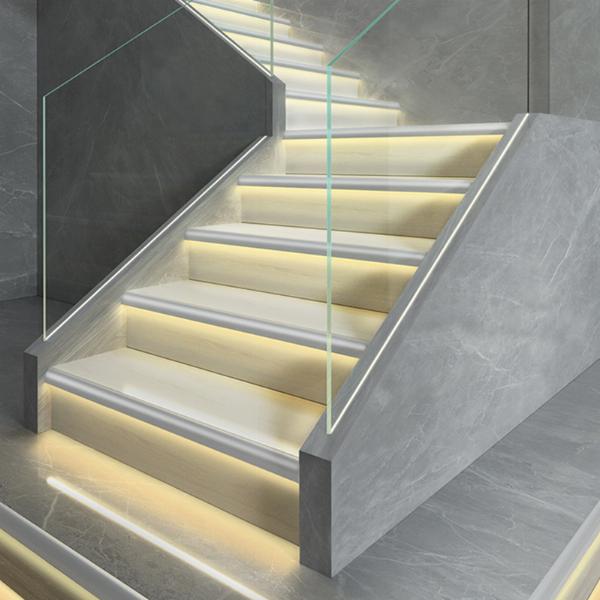Beginner Guide: How to Install Stair Nosings?

Strong 8k brings an ultra-HD IPTV experience to your living room and your pocket.
When considering the safety and aesthetics of a stairway the role of stair nosing cannot be overstated. Stair nosing is more than just a functional component designed to protect the edges of the stairs—it's a crucial element that enhances the overall look and feel of your space. Whether it's a residential home, a commercial office, or an industrial facility, the addition of stair nosing significantly elevates the visual appeal of the staircase.
However, the benefits of stair nosing extend far beyond aesthetics. Safety is a paramount concern, especially in high-traffic areas where the risk of slips and falls can be greatly reduced through proper stair design. Stair nosing adds a robust layer of safety by providing a clearly defined edge on each step, which helps in reducing accidents and enhancing the visibility of the stairway. This dual functionality of improving both the safety and the aesthetic aspects of stairs makes stair nosing an essential feature for any stair construction or renovation project.
In this guide, we will delve into the various types of stair nosing available, explore the materials commonly used, and provide you with a detailed walkthrough on how to correctly install stair nosing to maximize both its functional benefits and its visual impact.
Comprehensive Understanding of Stair Nosing
Understanding the variety and functionality of stair nosing is key to selecting the right product for your needs. Whether enhancing a residential staircase or ensuring compliance with safety standards in a commercial setting, the type of nosing you choose plays a crucial role in the overall effectiveness and appeal of the installation.
Types of Nosing
Stair nosing comes in several distinct types, each designed for specific applications and aesthetic preferences. Here, we delve into the most commonly used nosing types to help you make an informed decision:
- Bullnose Nosing: Characterized by its rounded edge, bullnose nosing is a popular choice for residential properties. It provides a smooth, curved transition on each step, which not only enhances the stair's safety by minimizing sharp edges but also adds a touch of elegance.
- Infill Nosing: This type of nosing is designed to accommodate a filler material, such as rubber or a specialized tread, to increase slip resistance. It is ideal for high-traffic areas or environments where additional traction is necessary.
- Ramped Edge Nosing: Often used in commercial settings, ramped edge nosing features a sloped profile that helps in reducing trip hazards. Its design is particularly beneficial in locations that require accessibility for individuals with mobility issues.
Each of these nosing types offers different aesthetic and functional benefits, making them suitable for various environments and design specifications. By understanding the specific applications of each type of nosing, you can better tailor your stair design to meet both safety standards and visual expectations.
Material Selection
Choosing the right material for stair nosing involves considering both the environment in which it will be installed and the desired durability. Here are some of the most common materials used for stair nosing, along with their advantages and drawbacks:
- Metal Nosing: Known for its durability and strength, metal nosing is an excellent choice for outdoor and industrial applications. It can withstand extreme weather conditions and heavy foot traffic. However, it may be more prone to corrosion if not properly treated or if used in salty, coastal climates.
- Wood Nosing: Wood adds a warm, natural element to staircases but requires more maintenance to keep it looking its best. Suitable for indoor use, wood nosing complements traditional home designs and can be customized with various stains and finishes.
- Vinyl Nosing* Vinyl is a cost-effective and versatile option, available in numerous colors and styles. It's resistant to moisture and mild wear, making it suitable for indoor residential or light commercial use. However, it may not withstand heavy wear and extreme conditions as well as metal or wood.
- Rubber Nosing: Rubber is another popular choice for its non-slip properties and shock absorption. It's particularly effective in schools, public buildings, and other areas where slip resistance and cushioning are priorities.
By carefully selecting the types of nosing and the materials used, you can ensure that your staircase not only meets the required safety standards but also aligns with the aesthetic values of your space. The right choices can significantly enhance both the functionality and the visual appeal of your stairway.
Pre-Installation Strategy
Before diving into the installation process, a strategic approach to planning is essential to ensure that the selected stair nosing meets both functional needs and regulatory standards.
Needs Assessment
To determine the most appropriate type of stair nosing for your project, consider the following factors:
- **Traffic Volume:** Assess the expected volume of foot traffic. High-traffic areas such as public buildings or commercial spaces may require more durable nosing, like metal or heavily treaded materials.
- **Type of Use:** Consider the nature of use—whether the stairs are used primarily by adults, children, people with disabilities, or carrying heavy loads. Each scenario may dictate different features in nosing, such as non-slip surfaces or more visually distinct markings.
- **Wear and Tear:** Evaluate potential wear and tear based on environmental conditions, such as exposure to weather in outdoor settings or chemical spills in industrial areas.
Compliance with Regulations
Understanding and adhering to building codes and safety standards is crucial:
- **Building Codes:** Familiarize yourself with local and national building codes that dictate specifics about stair construction and safety features, including nosing.
- **ADA Compliance:** For public buildings in the United States, ensure compliance with the Americans with Disabilities Act, which includes requirements for stair nosing to aid those with visual impairments.
- **Safety Standards:** Check for any other relevant safety standards that might apply based on the building's location and intended use.
Preparation Steps
Proper preparation of the stairway and gathering the right tools and materials are critical steps that directly affect the installation's success.
Essential Tools and Materials
The following tools and materials are typically necessary for installing stair nosing:
- **Measuring Tape:** For precise measurements of each step.
- **Saw:** A power saw or hand saw suitable for cutting the chosen nosing material to the exact length.
- **Drill and Drill Bits:** For creating pilot holes for screws, tailored to the hardness of the nosing material.
- **Screws and Fasteners:** Appropriate for the material of both the stair and the nosing.
- **Adhesive:** Select a high-quality construction adhesive compatible with both the stair and nosing materials.
- **Level:** To ensure all nosings are installed flat and even.
- **Sealant:** Especially for outdoor installations, to protect against moisture and weather.
Stair Surface Preparation
Properly preparing the stair surfaces is key to a successful installation:
- **Cleaning:** Ensure that all surfaces are clean, dry, and free of debris. Use a brush or vacuum to remove loose particles.
- **Checking for Damage:** Inspect each step for damage such as cracks, chips, or uneven areas. Repair these issues before proceeding.
- **Leveling:** Use a level to check each step for flatness. Apply leveling compound to any uneven areas and allow it to dry completely.
- **Sanding:** For wooden stairs, sanding may be necessary to smooth out the surface and ensure the adhesive and nosing bond securely.
Taking the time to meticulously prepare and plan your stair nosing installation will not only simplify the process but also ensure a safer and more durable finish. These steps are crucial in laying a solid foundation for a successful project.
Installation Techniques
Effective installation of stair nosing is pivotal for both safety and aesthetics. Here’s a step-by-step guide, including handling complex installation scenarios.
Step-by-Step Installation Guide
1. **Measure and Cut:** Begin by accurately measuring the length of each stair edge where the nosing will be applied. Cut the nosing to size, considering any special features of the stairs, such as curves or angles.
2. **Dry Fit:** Before adhering, place the nosing on the stairs to ensure a correct fit. Adjust as necessary.
3. **Apply Adhesive:** Spread a consistent layer of adhesive recommended for both the stair material and the nosing. For tricky areas like curved stairs, consider using a flexible adhesive that allows some movement during setting.
4. **Secure Nosing:** Place the nosing firmly onto the adhesive-lined edge of the stair. Apply pressure or use clamps to hold it in place as the adhesive sets, following the manufacturer’s recommended cure time.
5. **Fasten Securely:** Once the adhesive has set, use screws or nails at recommended intervals to secure the nosing into place permanently. Ensure that all fasteners are flush with or below the surface to prevent tripping hazards.
Troubleshooting Guide
- **Misalignment:** If the nosing is misaligned, promptly adjust before the adhesive sets. For pre-set adhesive issues, carefully remove the nosing, reapply adhesive, and realign.
- **Adhesive Failure:** Should the adhesive not hold, ensure the surfaces were properly prepared (clean, dry, and free from debris). Reapply using a different adhesive type if necessary, especially in varying temperature and humidity conditions.
Post-Installation Care
The longevity and appearance of your stair nosing largely depend on proper care and maintenance.
Finishing and Decoration
- **Sealing:** Apply a sealant to wood and metal nosings to protect against moisture and wear. Choose a sealant that complements the material’s characteristics and matches the overall décor.
- **Painting:** If painting is desired, use a durable, non-slip paint suitable for high-traffic areas. Test the paint on a small section first to ensure compatibility and appearance.
Maintenance Advice
- **Regular Cleaning:** Use a gentle cleaner appropriate for the nosing material. Avoid abrasive tools that might scratch or damage the surface.
- **Periodic Checks:** Regularly inspect the nosing for any signs of wear, loose fasteners, or damage. Address these issues promptly to maintain safety and aesthetics.
Expert Tips and Customization
To enhance the functionality and design of your stair nosing, consider these professional insights and customization options.
Professional Recommendations
- **Consult Experts:** Engage with professional installers or manufacturers to understand the best practices for specific materials and designs.
- **Advanced Techniques:** For complex installations, such as spiral staircases, seek advice from specialists who have experience with similar projects.
Customization Techniques
- **Personal Touch:** Add decorative elements like metal inlays or custom color treads that reflect personal style or branding.
- **Functional Customizations:** Consider integrating tactile or visual cueing directly into the nosing for enhanced safety in commercial or public spaces.
Concluding Thoughts
Successful stair nosing installation requires meticulous planning, precise execution, and ongoing maintenance. By adhering to established safety standards and building regulations, you not only ensure the functionality and beauty of your staircases but also safeguard the well-being of all users. Whether you’re a novice DIY enthusiast or a seasoned professional, understanding these principles will significantly contribute to the success of your stair nosing project.
Note: IndiBlogHub features both user-submitted and editorial content. We do not verify third-party contributions. Read our Disclaimer and Privacy Policyfor details.


